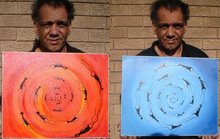Australian Aborigines have been painting the stories of the Dreaming on the walls of caves and rock shelters for at least 60,000 years. For the Aborigines, art was not "art for art's sake". They considered art to be a gift of supernatural power handed down from the Dreamtime ancestors. Nearly all Aboriginal art had a religious connotation, although some paintings were made to depict everyday events such as hunting. These acted as a type of Aboriginal archive. Aboriginal painting had a symbolic significance. Artists painted what was spiritually relevant to them in a particular area of land and to perpetuate their relationships with the Spirit Beings of that area. Aboriginal artists were confined by the subject matter and patterns that were relevant to their social group and ritual occasions. Aboriginal art was also influenced by the nomadic way of life and the materials that were available.

Basic colours used in painting were red from different sources in different areas, yellow from ochre, black from manganese or charcoal, and white from pipeclay or gypsum. Various fixatives were used, such as beeswax and honey, egg yolk, emu fat and tree sap. In more recent times, some Aboriginal artists have adapted non-traditional materials such as canvas and acrylic paint to depict many traditional designs for their own use and for the commercial market. In traditional Aboriginal society, both the making and the viewing of certain motifs and designs were restricted to specific initiated individuals. There was men's art and women's art.




No comments:
Post a Comment